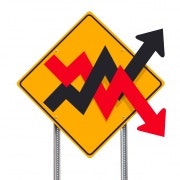America: Home of the brave
PORTFOLIO POINT: The strong run in US equities is looking shaky right now, but emerging markets are solid and the outlook should improve in the second half.
Investors are not only seeking safety in US equities; they’ve increased their conviction on US growth by rotating into US domestic cyclicals. This has been a winning strategy in the year to date, and in light of Greece’s electoral paralysis and weak trade data out of China, it’s unlikely to be quickly reversed. However, we question whether this “levered America” play offers suitable risk/reward going forward, given the projected economic weakening and unprecedented fiscal/political uncertainty lurking ahead. Not only are investors overly levered to US economic fortunes, global risk markets are equally exposed to an outsized reaction to less-than-positive news on US growth.
We think the very recent price action is instructive, and a possible window into the balance of 2012. For example, over the past few trading sessions, US domestic cyclicals such as consumer discretionary have helped lead the negative price action, while the volatility gap between materials and consumer discretionary has shrunk markedly. Bond markets are also showing scepticism about the US outlook, with falling real interest rates signalling slower growth, rather than higher inflation, while the CDS market for US sovereign risk has continued to trade wider.
With this backdrop, we continue to focus on relative-value trades and would take advantage of cheap volatility. Despite the renewed doubts about Greece’s future in the eurozone and the protracted nature of recapitalising Spanish banks, volatility across asset classes remains low. A closer look at the Chinese trade data reveals a better picture than the headline numbers suggest, with signs of strength in the consumer offset by infrastructure spending that has yet to pick up materially. Additional easing will provide for more upside.
Global Cross-Asset Strategy Overview
Base Case (12-month view)
On a long-term strategic perspective, we are bearish on developed market equities, while bullish on emerging market assets. DM is in a multi-year deleveraging cycle fraught with numerous negative feedback loops, and faces a long, difficult road to economic recovery as a result. In contrast, the strong secular fundamentals for EM economies should continue.
Our base case is slowing global growth, and divergence between anaemic DM and solid EM. Our economists forecast global growth of 3.7% in 2012, with EM at 6.1% and DM at 1.3%. European recession is our base case; US and EM recession is in the bear scenario. Risks are to the downside on constrained policy and potential fiscal tightening.

Sovereign risk should gradually ease as the eurozone makes progress towards a fiscal union. But the tail risk of a disorderly EMU break-up remains, as the process is likely to be protracted and uneven. The ECB has provided a bridge to the final fiscal and institutional solution, but its effectiveness in the future may be impaired by claiming seniority status to other creditors.
The EM outlook should improve in 2H12, with increased regional differentiation. Growth remains moderate, but policy easing should improve the outlook by 2H12. China is key; a soft landing still looks likely, and increased stimulus is likely to help growth pick up, starting in 2Q12.
Stay nimble on binary risks skewed to the downside and high volatility. With policy and politics still dominant, markets are likely to remain tactically oriented and range-bound.
Asset Class Views (3-6 months)
We maintain a cautious position as the risk asset correction is likely to continue. Doubts remain about US growth, sovereign risk has returned in Europe, and central banks are in a holding pattern. Overall, our preference for credit over equities hasn’t changed, and we continue to favour yield and carry strategies.
Credit still on top, but not overly compelling. Significant tightening will be difficult in Europe without a decline in sovereign spreads, while the US cyclical outlook favours HY over IG with yields so low. Concern about the Fed’s Maiden Lane III portfolio has made CMBS cheap.
Equity preference tilting towards Asia. AxJ equities should benefit from easing in China. Within DM, better growth and lower risks in the US relative to Europe are enough to offset more expensive valuations. First-quarter earnings and guidance have been okay, and are unlikely to be a catalyst either way.
Neutral on Bunds and Treasuries. With sovereign stress in Europe rising and mixed US data, any further weakness could trigger more policy easing. The flight to safety bid should also keep the yields low.
Bullish on USD, bearish EUR. The potential escalation of sovereign risk in Europe or additional easing by the ECB will keep the euro under pressure. Safe haven status and the lower probability of QE3 support the US dollar.
Caution on commodities. Global growth uncertainties warrant caution. A stronger US dollar works against commodities, as does the diminished prospect of more QE. Easing geopolitical risks could weaken oil, as the fundamentals still point to lower prices.
*This is an edited version of a research note from Morgan Stanley.
![]() Gerard Minack is head of global developed market strategy at Morgan Stanley.
Gerard Minack is head of global developed market strategy at Morgan Stanley.













